FIELD MONITORING
AND LABORATORY STUDIES GIVE WINDOW INTO EXCEPTIONAL
PERMANENCE
ABSTRACT
Our most recent
newsletter featured a case study about a segment
of Interstate Highway pavement in New Mexico, designed
with its base course and subgrade treated with the
innovative EMC SQUARED System liquid stabilizer
products. As of 2024 the extended service life of
this pavement will be eight times beyond the lifespan
of the conventionally designed pavement that it
replaced.
https://stabilizationproducts.net/newsletters_buriedtreasure.html
The previous pavement failed and required full depth
replacement within three years of its construction,
in spite of being designed with a thick layer of
asphalt pavement placed on top of a cement treated
base (CTB) course. Also of note, highway pavements
constructed in Texas that used these same liquid
stabilizer products for treatment of subgrade soils
remain smooth running and in excellent condition
over this same extended time, remaining far smoother-running
than nearby highways built on subgrade soils that
were treated with cement, fly ash and lime, three
calcium-based chemicals. In all cases, the exceptional
performance of the pavements designed with base
courses and subgrades treated with EMC SQUARED System
stabilizer products is even more noteworthy because
these highways were constructed on top of the most
highly problematic soils and worst-case ground conditions.
Compared to the calcium-based chemical stabilizers
and the geosynthetic products that the Federal Highway
Administration (FHWA) promotes online and in the
training courses they provide regarding soil stabilization
and base reinforcement, more innovative product
technology is now delivering superior results in
prolonging the smooth-running behavior of asphalt
and concrete pavements. The monitoring and measurement
of pavement smoothness according to the International
Roughness Index (IRI) is internationally recognized
as the most important measure of highway pavement
performance. It provides a means to evaluate and
compare the performance of different reinforcement
and stabilization products in prolonging the lifespan
of pavements. While the EMC SQUARED System products
produced exceptional results in the field and in
materials testing laboratories, proponents of the
old calcium-based chemical treatments dismissed
the impressive performance of the newer generation
products on the basis that they hadn’t yet
withstood the test of time by demonstrating the
permanence of their benefits in major highway applications.
Now that the tables have turned, with highways constructed
on EMC SQUARED treated materials maintaining superior
smoothness and pavement condition for well over
two decades, the opportunity is here to review the
engineering basis behind the exceptional performance
record of these advanced stabilizer products. This
report will summarize materials testing conducted
by the State of New Mexico and the New Mexico office
of an internationally prominent geotechnical and
materials testing firm, as well as the results from
three research studies conducted by two of the most
highly regarded university-based highway engineering
organizations in the United States.
LABORATORY
TESTS PROVIDE THE ENGINEERING BASIS FOR DESIGNING
HIGHWAYS WITH BASE COURSE AND SUBGRADE STABILIZED
WITH EMC SQUARED SYSTEM STABILIZATION TREATMENTS
Presented here is
an assortment of laboratory test results from independent
third-party studies conducted by highway research
and materials engineers in the interest of helping
reviewers better understand why these newer generation
stabilizer products are so successful in the most
important of all performance categories: Prolonging
Pavement Smoothness and Extending Pavement Service
Life. In regard to the Interstate Highway success
story in New Mexico that is referenced above, constructed
as a Federal Highway Administration (FHWA) Demonstration
Project under the direction of the New Mexico Department
of Transportation (NMDOT), only limited testing
took place in the state’s materials testing
laboratories prior to or during construction. Unconfined
Compressive Strength (UCS) tests were conducted
with soil materials sampled from the Interstate
40 MP 93– MP 97 project and treated with EMC
SQUARED System liquid stabilizer products. As illustrated
in the state’s UCS test results shown below,
the subgrade soils treated with the EMC SQUARED
System stabilizer treatment easily exceeded the
200 psi minimum after 7 days curing that the state
had set as their standard for stabilized soils used
in highway subgrade construction.
NEW
MEXICO DEPARTMENT OF TRANSPORTATION UCS TEST RESULTS
In the interest
of serving reviewers with a wider range of engineering
test data regarding the performance benefits yielded
by this stabilizer treatment, the Albuquerque office
of AMEC Earth & Environmental (now Wood Group)
was contracted to conduct additional tests with
soils sampled from the Interstate 40 project. This
laboratory study included Resistance Value (R-value)
testing of both the untreated soil and soil treated
with EMC SQUARED System stabilizer products. By
testing soils treated with the stabilizers, as well
as testing the same soils without the addition of
the stabilizer treatment, reviewers are given the
ability to compare performance values both before
and after the application of the stabilizer treatment,
and ascertain the extent of improvement. UCS testing
measures shear strength, while the R-value is a
stiffness test measuring the resistance of compacted
aggregate and soil materials to deformation. AMEC
staff also sampled soils from two other NMDOT highway
locations and subjected those soils to both UCS
and R-value tests to afford reviewers with the additional
perspective on the performance of the stabilizer
products in treatment of three different soil materials.
In the case of each of the three soil materials,
the EMC SQUARED System treatment proved notably
effective, an example being the Unconfined Compressive
Strength test results from the state materials laboratory
graphed below.
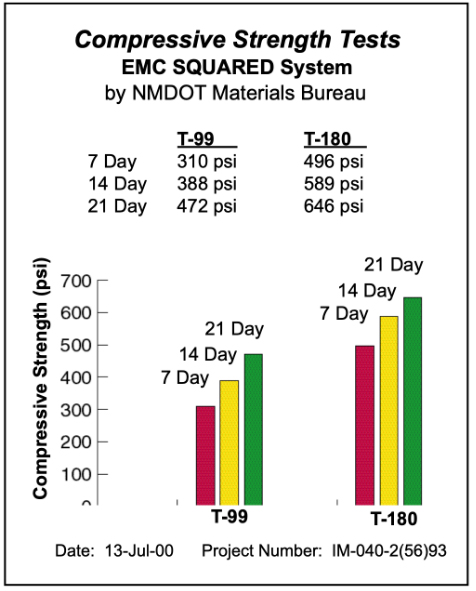
This laboratory testing
series measured the increasing strength of the stabilized
material over time and evaluated the gain in strength
achieved by using the level of compaction energy
specified for application of the EMC SQUARED Stabilizer
products. https://stabilizationproducts.net/docs/18846.pdf
The performance
of the Interstate 40 pavement (Eastbound MP 94–MP
96) constructed over worst case native ground conditions
with its subgrade and base course layers stabilized
with EMC SQUARED System treatments has proven exceptional
for more than two decades. Referencing the White
Paper available via the hyperlink above, the results
of the R-value laboratory tests associated with
the EMC SQUARED Stabilized Subgrade for this segment
of interstate highway reveal in laboratory language
just how major the improvement EMC SQUARED Stabilizer
treatment made in increasing the resistance of the
stabilized soil to deformation. For reviewers not
versed in the R-value test index, an aggregate material
must test at R-value 78 or higher to meet specifications
for highway base course applications (Caltrans).
An R-value of 10 is considered the equivalent of
CBR 1, the very lowest number value on the CBR index
and representative of a soil with extremely poor
load bearing capacity. As the R-value test results
graphed in the White Paper illustrate, we can see
that the untreated soil sampled from the I-40 subgrade
was improved by the application of the EMC SQUARED
System treatment from a very low R-value of 11 up
to an R-value of 71, nearly meeting the specification
requirements to qualify as an aggregate base course
material. Another clayey soil sampled from the subgrade
of US 550, a highway project similarly located in
northwestern region of New Mexico, was improved
to an even higher R-value by the same stabilization
treatment.
RESEARCH STUDY
#1 – MOISTURE-RESISTANT STABILIZED AGGREGATE
MATERIALS
The pavement design
of the Eastbound MP 94–MP 96 segment of the
I-40 Demonstration Project incorporated the installation
of an EMC SQUARED Stabilized Aggregate base course
layer in combination with the EMC SQUARED Stabilized
Subgrade, further increasing the stiffness of the
pavement structural section and reducing the moisture
and frost susceptibility of the critically important
foundation layers under the asphalt pavement. While
no testing was conducted by the State of New Mexico
at that time to evaluate the performance of the
EMC SQUARED Stabilized Aggregate material or the
aggregate material prior to application of the stabilizer
treatment, it is fortunate that testing was later
conducted at two nationally recognized materials
testing laboratories on EMC SQUARED Stabilized Aggregate
mixtures formulated with the same and similar aggregate
materials sampled from another project in New Mexico.
The same aggregate material treated with the EMC
SQUARED Stabilizer that was used in construction
of the base course for Eastbound MP 94–MP
96 segment of the Demonstration Project, was evaluated
in a Tube Suction Testing study conducted at the
Texas Transportation Institute (TTI) at Texas A&M
University. Tube Suction Testing uses dielectric
values and electrical conductivity, two electrical
property measurements, to determine which aggregate
base course materials are appropriate for use in
road construction and to identify those that are
prone to failure as a result of their moisture and
frost susceptibility. The aggregate base material
identified in the study as New Mexico was sourced
from the supplier that produced the crushed aggregate
base materials used in the construction of the previously
referenced Demonstration Project on Interstate 40.
As illustrated in the graph of the Tube Suction
Test results shown below, this New Mexico aggregate
was a highly moisture and frost susceptible material
and it was used extensively, without the application
of the stabilizer treatment, for many other I-40
reconstruction projects in this same area of New
Mexico. The extremely poor performance of this aggregate
source in the Tube Suction Test conducted at TTI
is one important clue as to why this length of Interstate
40 has been so highly prone to premature pavement
failures. As is evident in reviewing the graphed
test results and the Research Report referenced
in the hyperlink below, this same problematic aggregate
material after treatment with the EMC SQUARED Stabilizer,
performed similarly to asphalt and concrete pavement
materials in resistance to damage by moisture and
frost effects.
https://stabilizationproducts.net/docs/18587.pdf
New Mexico
Aggregate Tube Suction Test Results
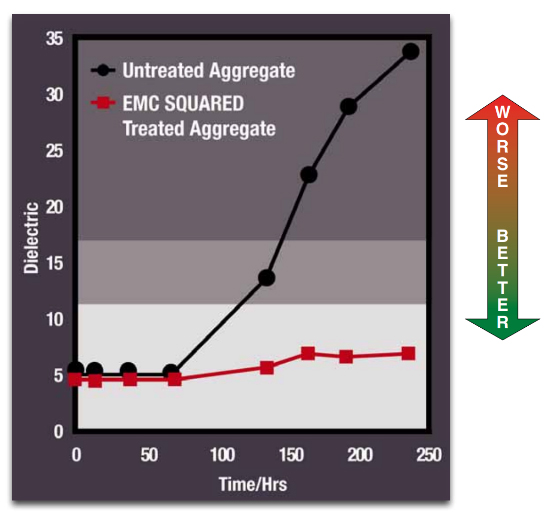
RESEARCH
STUDY #2 – NEW APPROACH TO STABILIZATION OF
SUBGRADE SOILS
The research study
summarized above was conducted at the Texas Transportation
Institute (TTI) using electrical property measurements
to evaluate the moisture and frost susceptibility
of aggregate materials, both before and after treatment
with the EMC SQUARED Stabilizer. A second study
conducted at TTI under the direction of Dr. Robert
Lytton, an internationally recognized authority
on the engineering behavior of expansive clay soils,
was focused on stabilization of soils rather than
aggregate materials. This second study also included
the use of electrical property measurements to determine
if a stabilized soil mixture has an acceptably low
level moisture susceptibility to be considered for
use in highway construction. Of important note,
the study was focused on stabilizing soils in a
manner not previously considered by highway engineers
schooled in the belief that the chemical soil stabilization
process is exclusively the realm of the calcium-based
stabilizers, cement, fly ash and lime. Dr. Lytton
defined the goal of the study as identifying a product
technology that would do something more than what
can be achieved with the application of bulk chemical
products, such as lime. In addition to effectively
increasing the strength and stiffness of the soil
so as to provide a stable working platform for construction
traffic, he also wanted to identify a chemical treatment
that would provide two additional benefits, the
first being “decrease the permeability of
the treated soil to reduce the amount of water penetrating
into the natural subgrade from the surface,”
and secondly to “decrease suction of the treated
soil below that of the natural soil so the treated
layer will not attract water from below.”
Dr. Lytton envisioned an entirely new approach to
defining the goal of subgrade stabilization. As
a result, we now have full scale highway demonstration
projects that have been in service for over two
decades, proving the wisdom of Dr. Lytton’s
insight into extending pavement service life by
using stabilizer products that improve the engineering
behavior of soils in radically different manner
than calcium-based chemicals. As he predicted, keeping
water out of the subgrade under pavements is the
key to extending smooth-running behavior and service
life. The FHWA Demonstration Project on I-40 featured
in the previous Newsletter is an outstanding example
of this new design concept at work.
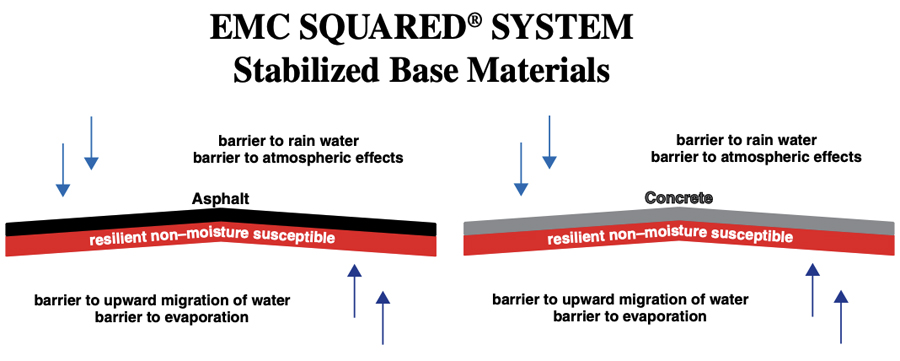
This second research
study at TTI was conducted for the purpose of identifying
an alternative to the use of lime stabilizer products
and consequently evaluated lime treatment as well
as the EMC SQUARED System stabilizer treatment for
sake of comparison. The study found the EMC SQUARED
System stabilizers to be “Superior to lime
treatment in terms of strength, stiffness, permeability
and swell resistance” and specifically recommended
their use for an interstate highway project and
a turnpike project that were subsequently constructed
on subgrades treated with EMC SQUARED System stabilizer
products. The final report recommended the use of
EMC SQUARED System stabilizer products as alternatives
to lime treatment and made special mention of the
suitability of water tight subgrades for construction
of highway pavements running across worst case ground
conditions and deep deposits of expansive clay soils.
https://stabilizationproducts.net/docs/18588.pdf
In regard to the suitability
of stabilized soils for subgrade construction, this
study set the upper limit for Electrical Conductivity
at 100 milliSiemens per centimeter. As documented
below, the soil stabilized with the EMC SQUARED
System treatment easily passed this test requirement,
and then tested even more impressively four months
after being continually subjected to moisture conditioning
treatment.
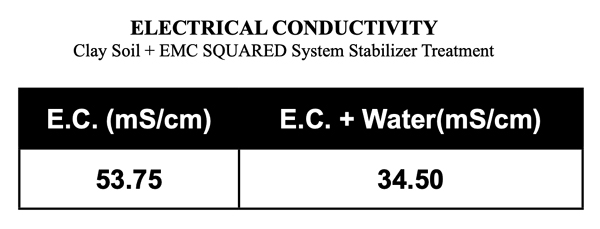
This study measured
the Dielectric Constant of an EMC SQUARED stabilized
soil material, setting the upper limit as a Dielectric
Value of 12, just below the Dielectric Value of
16, which is the point at which plastic deformation
of the pavement is predicted as the result of the
physical property changes in the soil driven by
moisture infiltration and fluctuations in moisture
content. Dielectric constants below 11 indicate
that the treated soil can adequately resist plastic
deformation and can maintain sufficient water tightness.
This study also evaluated the untreated or “raw”
soil, as well as the same soil treated with lime
chemical. As indicated below, the soil treated with
the EMC SQUARED System application was highly resistant
to moisture infiltration, while the raw soil and
the lime treated soil were both highly moisture
susceptible and unacceptable for subgrade construction.
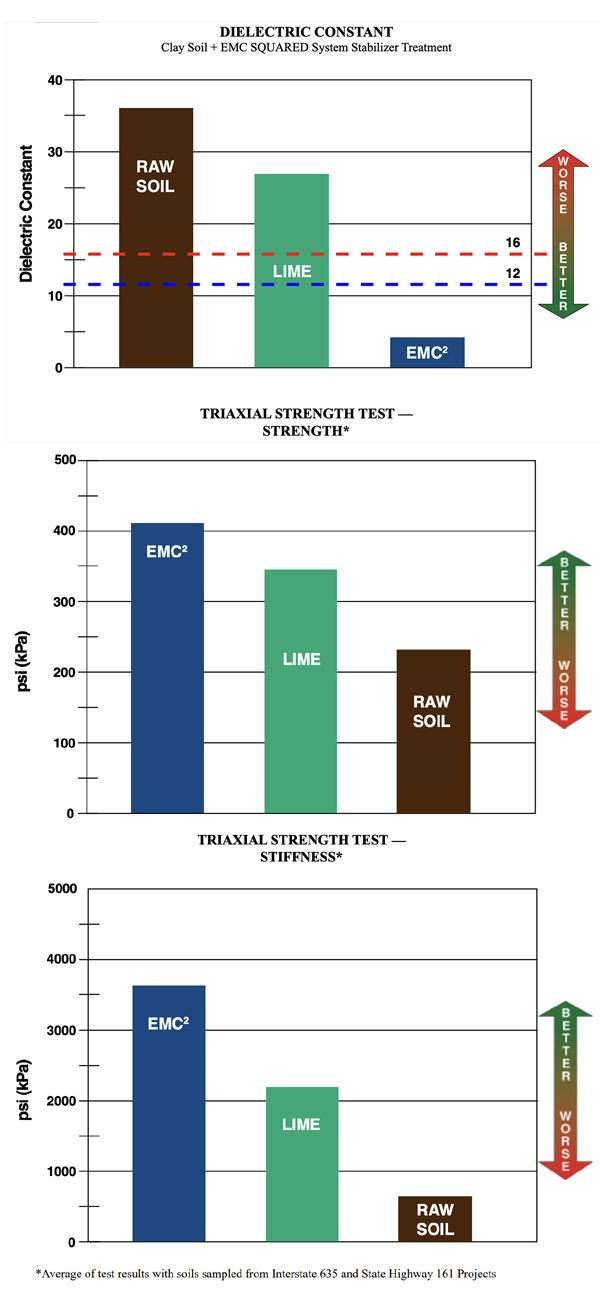
RESEARCH
STUDY #3 – PERFORMANCE OF EMC SQUARED STABILIZED
AGGREGATE IN PAVEMENT MATERIALS TESTING LABORATORY
EVALUATION
The third research
study relevant to the performance of the EMC SQUARED
Stabilized Aggregate base course layer within the
pavement structural section of the I-40 Demonstration
Project was conducted in the asphalt pavement materials
testing laboratory at the Western Regional Superpave
Center (WRSC) at the University of Nevada Reno.
The source of the untreated aggregate material used
in the Second Research Study was located in south
central New Mexico and was similar to the aggregate
source for the I-40 projects in gradation and plasticity.
This second project involved the construction of
over 116 miles of military supply roads designed
with a base course layer constructed with locally
available soils treated with applications of EMC
SQUARED Stabilizer and a running surface constructed
with EMC SQUARED Stabilized Aggregate materials.
Given the pavement-like performance of the stabilized
aggregate running surface, state-of-the-art Dynamic
Modulus and Repeated Load Triaxial (RLT) test methods
typically used to evaluate Hot Mix Asphalt pavement
materials were used to evaluate the stabilized aggregate
mixture and compare its performance with that of
typical hot mix asphalt mixtures. Hot Mix Asphalt
(HMA) is a viscoelastic material, meaning it loses
its modulus, or stiffness, as temperatures warm
or as load weights are increased. Responsive to
the viscoelastic nature of HMA materials, the Dynamic
Modulus test method evaluates the structural response
of HMA materials under various combinations of traffic
loads, speed and environmental conditions, including
temperature variations ranging from below freezing
to 130°F. To make an “apples versus apples”
comparison between a typical viscoelastic HMA mixture
and an elastic EMC SQUARED Stabilized Aggregate
pavement, the Dynamic Modulus and RLT were the test
methods that could provide a sophisticated and meaningful
comparison between these two different kinds of
flexible materials.
Interestingly, the
EMC SQUARED Stabilized Aggregate maintained elastic
behavior and consistently good modulus value regardless
of changes in temperature and loading frequency.
The stabilized aggregate, in fact, had a higher
modulus than the asphalt pavement in testing at
all temperatures ranging from below 70°F to
130°F (21.11°C to 54.44°C). Thirty thousand
pounds per square inch (30,000 psi) is typically
assumed in design as the modulus value for aggregate
base course materials. As graphed in the technical
summary report available in the hyperlink below,
the stabilized aggregate mixture had a modulus of
over 250,000 psi within 24 hours of curing and 475,000
psi after 7 days of curing. This is approximately
the same modulus as a typical asphalt mixture exhibits
when it is tested in Dynamic Modulus at a temperature
of 55°F (12.78°C). Much like concrete pavement
mixtures, EMC SQUARED Stabilized Aggregate mixtures
go on to cure and improve over time, but they are
ready to support traffic almost immediately upon
placement.
Based upon the results
of the Repeated Load Triaxial testing that was also
conducted in the WRSC pavement testing laboratory,
the conclusion of the study was that the stabilized
aggregate material “..is not anticipated to
generate any permanent deformation under a wide
range of loading conditions.” (Dr. Peter Sebaaly)
https://stabilizationproducts.net/docs/18828.pdf
SUMMARY
The presence of
a stabilized base course layer with such exceptional
engineering test values supporting the asphalt pavement
on the Eastbound MP 94 – MP 96 segment of
Interstate 40 helps explain why this particular
segment of heavily trafficked highway pavement is
going on 24 years of trouble-free service when the
previous conventionally designed pavement that it
replaced had completely failed after just 3 years.
As evident in this summary review of material testing
studies, there is a solid engineering basis behind
this demonstration of the permanence of EMC SQUARED
System stabilizer treatments on the Interstate Highway
System.
IMPLEMENTATION
PLAN
No one chemical
or mechanical stabilization product is going to
solve every problem, or turn every soil or aggregate
material into a high-stability, moisture-resistant
layer. While field testing is recommended whenever
feasible, modern performance-based laboratory test
methods can be used to design road and highway projects
that fully realize the cost benefits of including
stabilized base courses and subgrades constructed
with EMC SQUARED System stabilizer treatments. The
economic advantages of this process, typically a
third the cost of cement or lime treatment, and
a small fraction of the cost of importing crushed
aggregate materials, are so great that investment
in state-of-the-art laboratory testing and design
services is cost justified. Paralleling the old
saying “You have to spend money to make money,”
in order to save big money on construction costs
and extend pavement service life, a fraction of
one percent of the potential savings will need to
be invested in laboratory testing preliminary to
project design phase. Contact our office for technical
assistance.